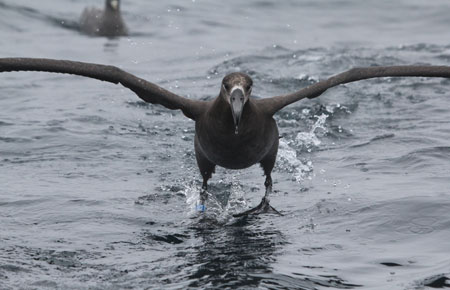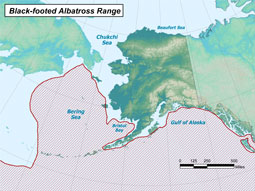Black-footed Albatross
(Phoebastria nigripes)
Species Profile
Did You Know?
Pair bonds between black-footed albatrosses are formed through ritualized dance displays.
General Description
The black-footed albatross is a large seabird 30–33 inches in length with an average wingspan of just over 7 feet (range of 6-8 feet). It is dark brown to black in color with black legs, bill, and feet. Adults have white under the eyes, at the base of the bill, and base of the tail.
Similar Species
The range of the black-footed albatross overlaps with two other albatross species: the short-tailed albatross and the Laysan albatross. The easiest way to distinguish the black-footed albatross from the other two species is its fairly uniform dark coloration. You can also distinguish the short-tailed albatross by its large pink bill.
Life History
Reproduction and Growth
The average age of sexual maturity for black-footed albatross is 7. The black-footed albatross is monogamous and pair bonds are maintained until one of the pair disappears or dies. Nests are made by creating a shallow depression in loose substrate and are generally built along sandy shorelines. Each year the pair will return to the same breeding colony and almost the exact same nesting site. Sexually mature black-footed albatross females lay only one egg per clutch.
Eggs are laid in November-December. The average incubation period is 66 days. Chicks hatch in January and February. The chicks are brooded by their parents for several days and guarded for up to one month. After this time, the parents spend most of their time at sea, returning only to feed their chick. The chicks fledge in June-July. When the chicks are born, they are uniformly dark colored. They will gain the white coloration pattern of adults as they age. Once they reach sexual maturity, the young albatrosses usually return to their natal colony to breed.
Feeding Ecology
The black-footed albatross is a surface feeder. It forages by surface-seizing, contact dipping, and scavenging. Its primary prey species include squid, fish, and other invertebrates.
Migration
Breeding adults travel to the nesting islands in October. They generally remain at the breeding colonies through June when they return to foraging grounds throughout the North Pacific. They migrate up to thousands of kilometers between their breeding colonies and summer foraging grounds.
Range and Habitat
The main breeding colonies of the black-footed albatross are located in the Northwest Hawaiian Islands. They also breed on small, remote islands in Japan, and there have been reports of new black-footed albatross breeding colonies in Mexico. They utilize sandy, wind-swept beaches for their nesting sites.
Outside the breeding season, the black-footed albatross is an open ocean species. They are most commonly seen over shelf breaks and along boundaries between water masses. The black-footed albatross is most concentrated northeast of Japan to the US West Coast. Along the west coast, they are often associated with the California Current. Alaskan waters constitute the northern end of their range. In the summer they can be found in the Gulf of Alaska and along the Aleutian Islands.
Status, Trends, and Threats
Status
Listed as threatened by the state of Hawaii.
NatureServe: Global – G3G4 (vulnerable-apparently secure)
State – S3S4N (vulnerable-apparently secure, nonbreeding population)
IUCN: Endangered
ESA: Under review
Trends
In the late 1800s and early 1900s, black-footed albatrosses were almost wiped out by feather hunters. Later, rabbits were introduced to their breeding colonies and destroyed their nesting habitat. In the 1950s and 1960s, the birds were culled by the military to reduce the number of collisions with aircraft. The black-footed albatross was able to recover from each of these severe population declines. However, the population is currently experiencing a slight decline.
Threats
Incidental take in fisheries, habitat loss and degredation, pollution, climate change (sea level rise, changes in storms/weather).
Fast Facts
-
Size
30–33 inches long, 6–8 foot wingspan -
Lifespan
12–40 years -
Range/Distribution
Throughout the North Pacific from Japan to the US West Coast -
Diet
Squid, fish, and other invertebrates -
Predators
Tiger sharks -
Reproduction
Monogamous, mate for life, lay single egg


